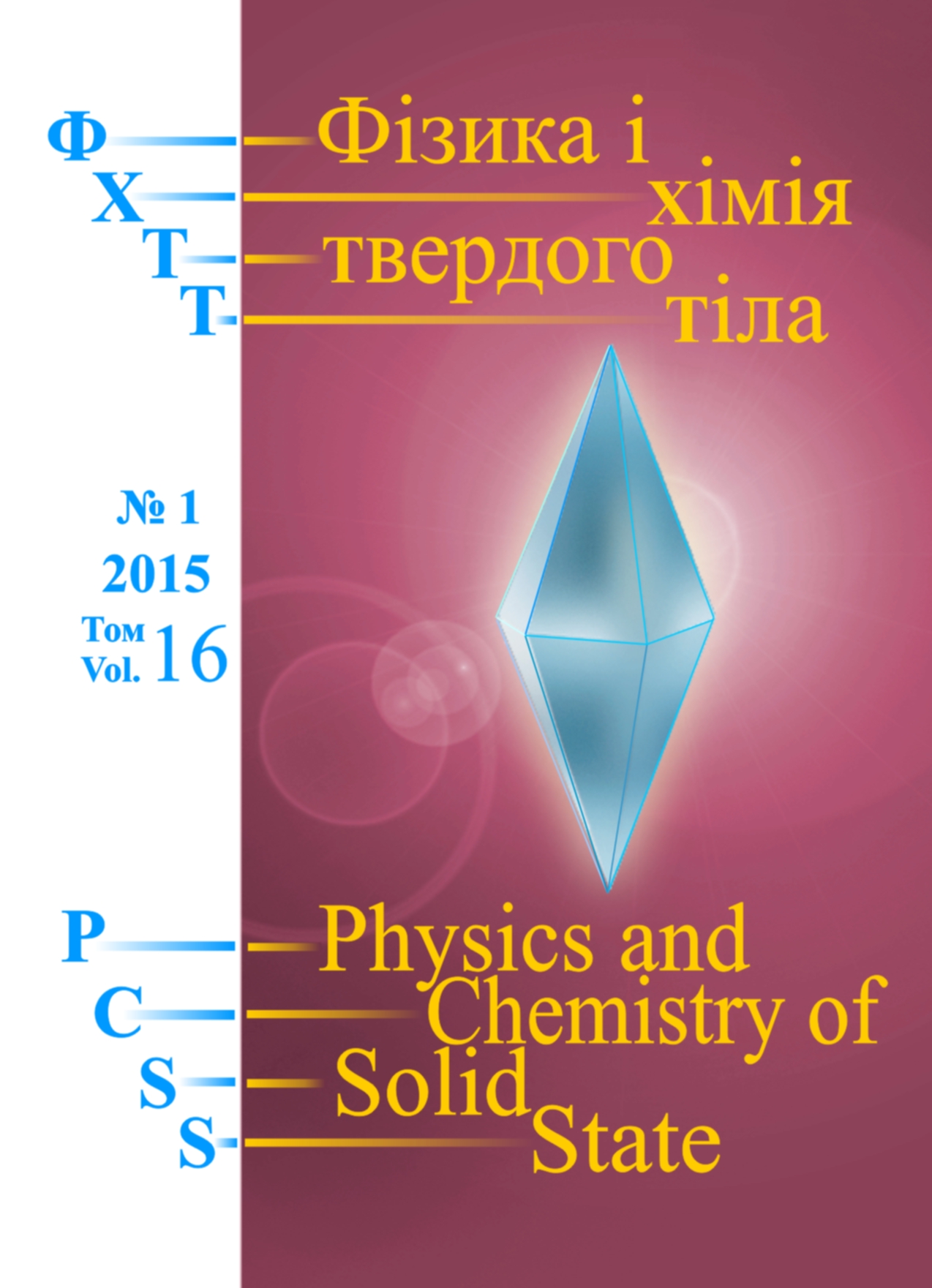Physics and Chemistry of Solid State
2015 Vol.16 №1 |
||
|
|
||
DOI: 10.15330/pcss.16.1.104-110
V.Ya. Gvozdetskyi, R.E. Gladyshevskii, N.V. German
Multicomponent Phases with CeAl2Ga2- and Y0.5Co3Ge3-Type Structures in the Gd–Ca–Fe–Co–Ge System
Department of Inorganic Chemistry, Ivan Franko National University of Lviv, Kyryla i Mefodiya St. 6, 79005 Lviv, Ukraine, e-mail:volodymyr.gvozdetskyi@gmail.com
New quinary phases with the CeAl2Ga2 (tI10, I4/mmm) and Y0.5Co3Ge3 (hP8-2, P6/mmm) structure types were found at 500 ºC in the Gd–Ca–Fe–Co–Ge system based on X-ray powder diffraction data. They are Gd1 xCaxFe2 yCoyGe2 (x = 0.085(7)-0.551(6), y = 0.25-0.75, a = 3.99468(6)-4.00003(8), c = 10.1279(2)-10.3981(5) Å) and Ca0.5 xGdxFe3 yCoyGe3 (x = 0.031(1)-0.314(8), y = 0.75-2.25, a = 5.1081(1)-5.1218(1), c = 3.9751(1)-4.0451(2) Å). The c-parameter of the tetragonal CeAl2Ga2-type (122) phase cell depends much more on the Fe/Co and Gd/Ca ratios, than the a-parameter (which remains nearly the same). The volume of the 122 cell increases with increasing Fe and Ca content. The c-parameter of the hexagonal cell of the Y0.5Co3Ge3-type (0.533) phase also depends more strongly on the Fe/Co content than the a-parameter, but Gd/Ca substitutions have little effect on the cell parameters. The following new quaternary and ternary phases were also discovered: GdFe2 yCoyGe2 (y = 0.5-1.5, a = 3.99419(5)-3.99750(7), c = 10.3271(2)-10.1173(3) Å) with CeAl2Ga2-type structure and Gd0.5Fe3 yCoyGe3 (y = 0.75-1.5, a = 5.1247(8)-5.1225(7), c = 4.052(1)-4.010(1) Å), Ca0.5Fe3 yCoyGe3 (y = 0.75-2.25, a = 5.1153(2)-5.1066(2), c = 4.0451(2)-3.9839(3) Å), Ca0.5Fe3Ge3 (a = 5.10167(9), c = 4.06565(7) Å), and Ca0.5Co3Ge3 (a = 5.0899(2), c = 3.9199(1) Å) with Y0.5Co3Ge3-type structure. The latter two phases, together with the already known compounds Gd0.5Fe3Ge3 and Gd0.5Co3Ge3, are the parent compounds for the probably complete solid solution Ca0.5 xGdxFe3 yCoyGe3, just as the corresponding ternary compounds (except in the Ca–Fe–Ge system) with CeAl2Ga2-type structures open access to the Gd1 xCaxFe2 yCoyGe2 solid solution.
Keywords: Gd–Ca–Fe–Co–Ge system, intermetallics, solid solution, crystal structure.
Full text (on original language) .pdf
Home
Reference
[1] M. Rotter, M. Tegel, D. Johrendt, Superconductivity at 38 K in the iron arsenide (Ba1 xKx)Fe2As2, Phys. Rev. Lett. 101, 1 (2009).
[2] P. Villars, K. Cenzual (Eds.), Pearson’s Crystal Data, Crystal Structure Database for Inorganic Compounds (Materials Park (OH): ASM International, 2012).
[3] W. Kraus, G. Nolze, PowderCell for Windows, Federal Institute for Materials Research and Testing (Berlin, 1999).
[4] E. Parthé, L. Gelato, B. Chabot, M. Penzo, K. Cenzual, R. Gladyshevskii, TYPIX, Standardized Data and Crystal Chemical Characterization of Inorganic Structure Types (Springer-Verlag, Berlin, Vols. 1-4, 1993/1994).
[5] J. Rodríguez-Carvajal, Recent developments of the program FULLPROF, IUCr Newsletter 26, 12 (2001).
[6] V. Gvozdetskyi, N. German, R. Gladyshevskii, Quinary phases with CeAl2Ga2 and Y0.5Co3Ge3 structure types (Coll. Abstr. XIII Int. Sem. Phys. Chem. Solids, Lviv, 2012), p. 39.
[7] V. Gvozdetskyi, N. German, R. Gladyshevskii, Phase equilibria in the Gd–Fe–{Ga,Ge}–Sb system at 500ºС. Crystallographic parameters of the GdFe2Ge2 and GdFe0.52Ge2 compounds, Visn. Lviv. Univ., Ser. Khim. 53, 12 (2012).
[8] W. Rieger, E. Parthé, Ternäre Erdalkali- und Seltene Erdmetall-Silicide und Germanide mit ThCr2Si2-Struktur, Monatsh. Chem. 100, 444 (1969).
[9] G. Venturini, B. Malaman, X-ray single crystal refinements on some RT2Ge2 compounds (R = Ca, Y, La, Nd, U; T = Mn-Cu, Ru-Pd): evolution of the chemical bonds, J. Alloys Comp. 235, 201 (1996).
[10] W. Buchholz, H.U. Schuster, Intermetallische Phasen mit B35-Überstruktur und Verwandtschaftsbeziehung zu LiFe6Ge6, Z. Anorg. Allg. Chem. 482, 44 (1981).
